|
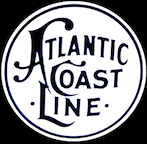 |
ACL Class R-1 4-8-4's
the
"Eighteen-hundreds"
|
(dropdown menu)
updated 22 February 2022
Specifications
|

|
| GENERAL
DATA |
| 28.
HEATING SURFACE, SUPERHEATER |
1,425
SQ. FT. |
|
| 1.
CYLINDERS: DIA. X STROKE |
27"
x 30" |
|
| 29.
HEATING SURFACE, EQUIVALENT
TOTAL |
6,891
SQ. FT. |
|
|
|
| 30.
GRATES, AREA |
97.7
SQ. FT. |
|
| 3.
VALVES, SIZE & KIND |
12"
PISTON |
|
|
| 4.
VALVE, MAXIMUM TRAVEL |
7
1/2" |
|
|
| 5.
VALVES, STEAM LAP |
1
3/8" |
|
AIR
BRAKE |
| 6.
VALVES, EXHAUST CLEARANCE |
1/4" |
|
| 33.
SCHEDULE |
W.A.B.
CO. TYPE 8-ET |
|
| 7.
VALVES, LEAD IN FULL GEAR |
1/4" |
|
| 34.
BRAKE PWR |
60%
DRVRS & 45% B. TRUCK @
50 LBS PRESSURE |
|
| 8.
VALVES, CUT-OFF IN FULL GEAR |
85% |
|
| 35.
PUMPS |
2-8
1/2" CROSS COMPOUND |
|
| 9.
RATED TRACTIVE POWER |
63,900
LBS. |
|
TENDER |
| 10.
RATIO OF ADHESION (WT. ON
DRIVERS/TRACTICE POWER) 4.12 |
|
| 11.
SHARPEST CURVE |
16
DEGREES WITH 1/2" TRACK
SPREAD |
|
| 37.
DRAFT GEAR |
MINER
A-5-XB |
|
| WEIGHT |
| 38.
BRAKE SCHEDULE |
W.A.B.
CO. TYPE 8-ET |
|
| 12.
LEADING TRUCK |
89,343
LBS. |
|
| 39.
BRAKE PWR |
100%
@50LB. PR. OF LT. WT. TNDR
(186,200 LBS.) |
|
| 13.
TOTAL DRIVERS |
263,127
LBS. |
|
| 40.
TRUCK, TYPE |
8
WHEEL RIGID FRAME, CAST
STEEL |
|
| 14.
TRAILER TRUCK |
107,800
LBS. |
|
MISCELLANEOUS |
| 15.
TOTAL ENGINE |
460,270
LBS. |
|
| 41.
INJECTOR |
NATHAN
TYPE HP |
|
| 16.
FRONT TENDER TRUCK |
222,450
LBS. |
|
| 42.
LUBRICATORS |
2
NATHAN MECH. DV-7 |
|
| 17.
REAR TENDER TRUCK |
213,050
LBS. |
|
| 43.
POWER REVERSE |
BALDWIN
TYPE "C" |
|
| 18.
TOTAL TENDER |
435,500
LBS. |
|
| 44.
DRIVING BOXES |
TIMKEN
ROLLER BEARINGS |
|
| 19.
TOTAL ENGINE & TENDER |
895,770
LBS. |
|
| 45.
FIRE DOOR |
FRANKLIN
BUTTERFLY TYPE No
8 |
|
| BOILER |
| 46.
SUPERHEATER |
ELESCO
TYPE "A" |
|
| 20.
WORKING PRESSURE, MAX. |
275
LBS. |
|
| 47.
HEADLIGHT |
GOLDEN
GLOW |
|
| 21.
FIREBOX, LENGTH X WIDTH |
138"
x 102" |
|
|
| 22.
TUBES, No,
O.D. & GA. |
198~2
1/4" ~No
11 B.W.G. |
|
| 49.
TRAIN CONTROL |
GENERAL
RY. SIGNAL |
|
| 23.
FLUES, No,
O.D. & GA. |
58
~5 1/2" ~No
8 B.W.G. |
|
| 50.
AIR PUMP LUBRICATOR |
WEST'G.
MECH. TYPE F-1 |
|
| 24.
TUBES & FLUES, LENGTH
(OUT. TO OUT. OF TUBE
SHEETS) |
252" |
|
| 51.
FEED WATER HEATER |
WORTHINGTON
OPEN TYPE 5 1/2 SA |
|
| 25.
HEATING SURF., TUBES &
FLUES |
4,185
SQ. FT. |
|
|
| 26.
HEATING SURF.,
FIREBOX,SYPHONS,
COMB.CHAMBER |
568
SQ. FT. |
|
| 53.
SPEED RECORDER |
VALVE
PILOT |
|
| 27.
HEATING SURFACE, TOTAL |
4,753
SQ. FT. |
|
|
General data on the R-1 from the ACL
The R-1's were the only "modern"
steam locomotives owned by the ACL, and featured cast
bed frames with cylinders and many accessories cast
integrally, cast pilots with drop-type couplers, ASF
roller bearings on leading axles, Timken roller
bearings on the driving axles with lateral motion
devices on the front axle, Baldwin disk drivers, 275
PSIG boilers, Type "A" superheaters, Worthington SA
feedwater heaters, front-end throttles, large
fireboxes with combustion chambers and equipped with
four thermic syphons, Elesco centrifugal steam
separators, extensive mechanical lubrication, and
massive 8-axle tenders. The engines featured jacketed
smokeboxes and were painted in a sharp two-tone
metallic gray/black paint scheme with silver striping,
lettering and driver tires. The ACL herald on the
tender was a separate embossed sheet metal disk which
was attached to the tender providing a dramatic change
from earlier engines which merely had "Atlantic Coast
Line" lettered on the tender. The detailed procedure
for painting the engines can be downloaded here: Baldwin
Locomotive Works Painting, Lettering and Numbering
Specification for the R-1 Locomotives
The R-1's were
overhauled at the ACL shops in Tampa, Florida, as
they were too large for the road's backshops in
Rocky Mount, North Carolina. Tampa is southwest of
the ACL's Jacksonville to Richmond mainline, which
required the locomotives to stray from their usual
operating territory when heavy repairs were
required. When a locomotive was sent to Tampa for
overhaul, it was used on a freight train into Tampa.
The R-1's were limited to 40 MPH over most of this
line south of Jacksonville, and even slower over
some bridges, so this must have been a headache for
the railway.
An interesting
feature on the R-1's which I have not seen on other
modern steam locomotives was the omission of wedges
from the frame pedestal openings. Wedges allowed the
gaps between the pedestal openings and the axle
boxes (which contained the roller bearings) to be
adjusted for proper clearance. Earlier versions of
wedges had to be manually adjusted by machinists
when the engines were brought in for maintenance.
Turning a bolt located below the wedge, raised or
lowered the wedge, reducing or increasing the
clearance between the frame opening and the axle
box. Around 1940, Franklin introduced self-adjusting
wedges, which included an adjustable spring to shift
the wedges to maintain proper axlebox clearance over
long periods without intervention by shop personnel.
The pedestal openings on the R-1's had to be
adjusted by inserting shims of the appropriate
thickness between the shoes and the frame. At
overhaul the axle openings in the frame would have
to be trued by grinding or welding up and then
grinding. Perhaps Baldwin or the ACL believed wedges
would no longer be needed with cast bed frames and
that adjustments would rarely be required, but this
was apparently not the case.
Interestingly,
according to former ACL machinist Jerald McGowan,
the main driving axles required replacement at every
overhaul as machinists invariably found a tiny crack
in the axle at the inner edge of the wheel hubs. It
was such a common problem that partially finished
replacement main axles were maintained in stock at
Tampa so they'd be available when the engines were
overhauled.
Interestingly, the drivers were not
keyed to the axles but relied on the press fit to
keep them quartered.
Few changes were made
to the R-1's during their careers. Provisions were
made in the original design to allow trailing truck
boosters to be fitted, but this was never done.
Photographs show that within the first couple of
years of service, the original whistles, mounted at
the steam dome and fed with saturated steam, were
replaced with larger whistles mounted on the
fireman's side of the boiler just behind the stack
on the superheater header, where they were fed with
superheated steam (see photo below). Headlights seem
to have been changed or modified on some if not all
of the locomotives as well. In the 1940's,
some or all of the locomotives were equipped with
Valve Pilot devices, which gave guidance to the
engineer operating a locomotive on the optimum valve
cutoff setting ensuring maximum operating efficiency
and fuel economy. Finally, locomotives 1800, 1801,
1806, 1807, 1808, and 1809 were fitted with Timken
light-weight pistons, piston rods, crossheads, and
new tapered main rods with roller bearing wrist pins
(see photos below). These components greatly
reduced the mass of the reciprocating parts which
improved the R-1's running gear balance even
further. At least some locomotives had some drivers
replaced with later versions of the Baldwin disk
drivers. A comparison photo of these is
provided as well.
ACL R-1 Details of
Interest
The photos below point out some minor
changes made to the R-1's during their service on the
ACL.
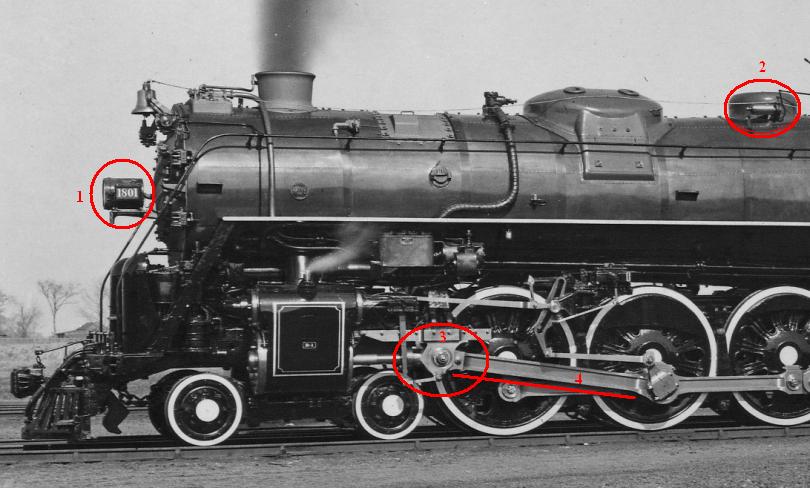
Builder's Photo
(above) of R-1 showing (1) original headlight, (2)
original whistle fed with saturated steam from the
steam dome, (3) heavy, one-piece forged crosshead
and (4) heavy, non-tapered main rods. This photo
also shows the ASF wheelsets on the lead truck,
indicated by the large hubs with bolts around the
perimeter, which were an interesting development
of the 1930's. These wheelsets included both
roller bearings and conventional journal
bearings on each axle. Apparently the purpose of
this arrangement was to allay the fears of
conservative railway managers, some of who did not
trust the relatively new roller bearings.
The friction bearings on the ASF wheelsets could
serve as a back-up if the roller bearings should
fail. Other notable locomotives equipped with
these axles were the massive 2-8-8-4's of the
Duluth, Missabe, and Iron Range Railway in
Minnesota. These axles, which were undoubtedly
considerably more expensive than a conventional
axle, were used for a relatively short time on new
locomotives, as railroads' experience proved the
reliability of roller bearings.
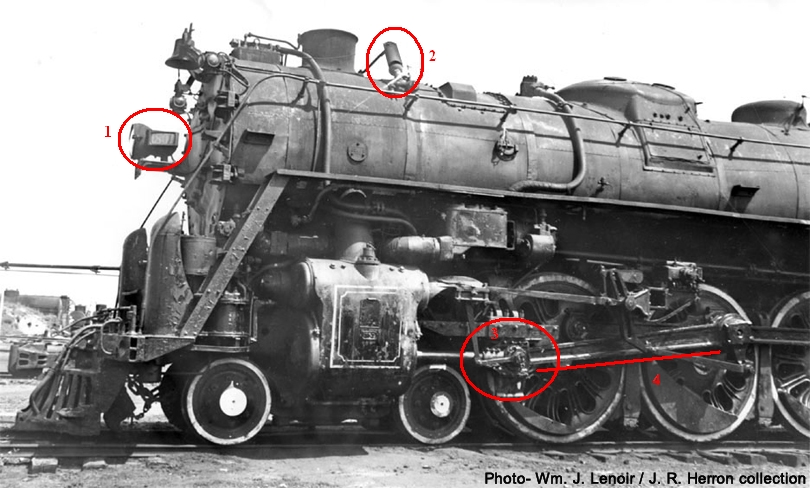
Late photo
(above) of ACL R-1 showing (1) what appears to be
a different headlight, (2) larger whistle fed with
superheated steam from the superheater header, (3)
Timken light-weight crosshead (not seen are Timken
light-weight piston and piston rod), and (4)
light-weight, tapered main rod with roller bearing
wrist pin. This photo unfortunately also shows the
dirty condition somewhat typical of most ACL
steam, especially near the end of steam on the
railway.
It appears the
original whistles were the standard Baldwin
Locomotive Works whistle, which was usually a
3-chime whistle. The later whistles which were
installed shortly after the locomotives were
placed in service were likely the Atlantic Coast
Line's own 6-chime whistles. You can hear one of
these whistles on this short clip from the 1952
movie "the Greatest Show on Earth", where a much
smaller ACL P-3 Pacific pulls a circus
train: Atlantic
Coast Line P-3 Whistle
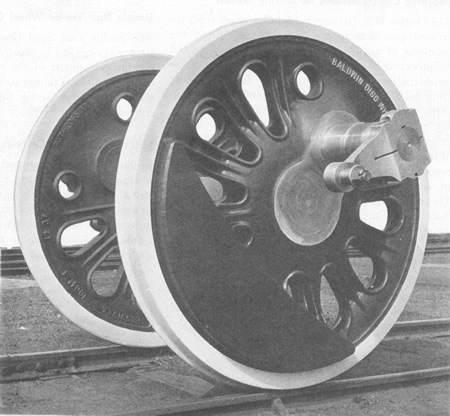
This photo shows
a brand-new set of Baldwin disk drivers awaiting
installation on a new steam locomotive, possibly
an ACL R-1. These wheels were of hollow
cross-section, similar to the better known Boxpok
drivers used on many modern steam locomotives.
Many contemporary Santa Fe locomotives were also
equipped with Baldwin disk drivers, and many other
locomotives on a variety of railways were retrofit
with these wheels during updates in the 1930's and
1940's. The ACL installed Baldwin disk main
drivers on many of their steam locomotives in the
1930's and 1940's including the P-5 Pacifics and
Q-1 2-10-2's. The hollow cross-section made the
wheels stronger and allowed more room for
counterbalancing material.
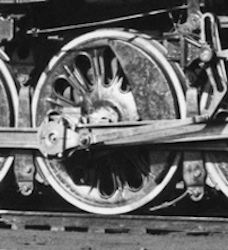 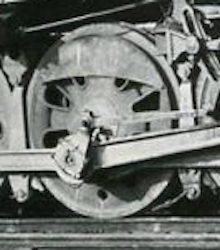
Baldwin later
somewhat simplified the design of these wheels by
omitting the raised ribs between the openings and
photos show that at least some R-1's wound up with
the newer version of the wheels. The two photos
above show the main drivers on R-1 no. 1808; the
left photo shows the original style and the right
photo shows the newer version of the wheels.
The other drivers were not changed on this
locomotive. Sante Fe 4-6-4 no. 3463, currently on
display in Topeka, Kansas also sports two
different versions of Baldwin disk drivers,
indicating some drivers were replaced over the
locomotive's life, so this may have been a common
issue. The reason for the change is not known, but
perhaps there were issues with at least some of
the wheels cracking after many miles of use.
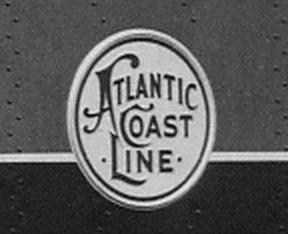
Another
interesting feature of the R-1's were the Atlantic
Coast Line heralds on the tender, which were
embossed 45 inch diameter plates bolted to the
sides of the tender rather than just a logo
painted directly on the tender sides. The plates
were provided by the Allen-Morrison Sign Company
of Lynchburg, Virginia. Allen-Morrison was famous
for making many of the now-collectible Coca-Cola
signs, as well as other signs used in advertising.
The builder's drawings for the locomotives show
that rivets were omitted in the area of the tender
where the heralds were installed. Welding was used
to secure the internal braces to the exterior
sheets in this area. The rivet-free area can be
seen on the photo of N&W 2084 with the herald
removed on the Disposition page.
The
R-1's were well-designed steam locomotives and
were nearly state-of-the-art for 1938, lacking
only roller bearing axles on the trailing truck
and tender axles. Their large fireboxes with
combustion chambers and 4 Nicholson Thermic
Syphons were among the largest in heating surface
area of any 4-8-4 and undoubtedly made them
prodigious steamers. One curious feature is
Baldwin's use of relatively small piston valves
for such large engines which seems to have been
part of Baldwin's design philosophy at the time.
The R-1's had only 12 inch diameter piston valves
whereas even the ACL's much smaller and older
Class P-5 Pacifics had 14 inch valves. The R-1's
also had somewhat smallish superheaters for their
size (Type A, 1425 square feet). These two items
would have restricted their "breathing" at high
speed by impeding the steam flow into and out of
the cylinders, resulting in a pressure drop from
the boiler to the cylinders. Later 4-8-4 designs
used 14 inch piston valves with even longer valve
travel and huge Type E superheaters to improve
their high-speed performance. Nonetheless, once
their balancing problems were corrected, the R-1's
were known as outstanding performers on the ACL
and their theoretical design deficiencies were not
seen as drawbacks when they were in service.
|





